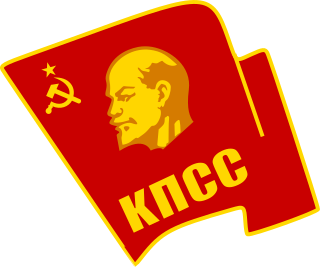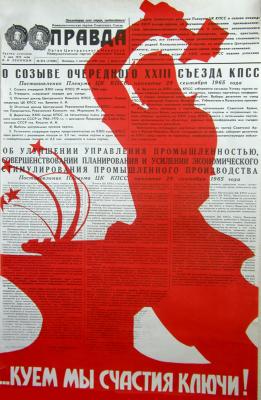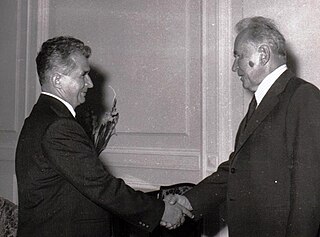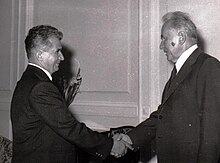
The Communist Party of the Soviet Union (CPSU), at some points known as the Russian Communist Party (Bolsheviks) and All-Union Communist Party (Bolsheviks), sometimes referred to as the Soviet Communist Party (SCP), and formerly known as the Bolshevik Party, was the founding and ruling political party of the Soviet Union. The CPSU was the sole governing party of the Soviet Union until 1990 when the Congress of People's Deputies modified Article 6 of the 1977 Soviet Constitution, which had previously granted the CPSU a monopoly over the political system. The party's main ideology was Marxism-Leninism.

Perestroika was a political reform movement within the Communist Party of the Soviet Union (CPSU) during the late 1980s widely associated with CPSU general secretary Mikhail Gorbachev and his glasnost policy reform. The literal meaning of perestroika is "restructuring", referring to the restructuring of the political and economic systems of the Soviet Union, in an attempt to end the Era of Stagnation.

Leonid Ilyich Brezhnev was a Soviet politician who served as General Secretary of the Communist Party of the Soviet Union from 1964 until his death in 1982, and Chairman of the Presidium of the Supreme Soviet from 1960 to 1964 and again from 1977 to 1982. His 18-year term as General Secretary was second only to Joseph Stalin's in duration. To this day, the value of Brezhnev's tenure as General Secretary remains debated by historians. While his rule was characterized by political stability and significant foreign policy achievements, it was also marked by corruption, inefficiency, economic stagnation, and rapidly growing technological gaps with the West.

Andrei Pavlovich Kirilenko was a Soviet statesman from the start to the end of the Cold War. In 1906, Kirilenko was born at Alexeyevka in Belgorod Oblast to a Ukrainian working-class family. He graduated in the 1920s from a local vocational school, and again in the mid-to-late 1930s from the Rybinsk Aviation Technology Institute. He became a member of the All-Union Communist Party (Bolsheviks) in 1930. As many like him, Kirilenko climbed up the Soviet hierarchy through the "industrial ladder"; by the 1960s, he was vice-chairman of the Bureau of the Central Committee of the Russian Soviet Federative Socialist Republic (RSFSR). After Nikita Khrushchev's forced resignation, Kirilenko became Leonid Brezhnev's "chief lieutenant" within the Central Committee.

Alexei Nikolayevich Kosygin was a Soviet statesman during the Cold War. He served as the Premier of the Soviet Union from 1964 to 1980 and was one of the most influential Soviet policymakers in the mid-1960s along with General Secretary Leonid Brezhnev.

Nikolai Aleksandrovich Tikhonov was a Soviet Russian-Ukrainian statesman during the Cold War. He served as Chairman of the Council of Ministers from 1980 to 1985, and as a First Deputy Chairman of the Council of Ministers, literally First Vice Premier, from 1976 to 1980. Tikhonov was responsible for the cultural and economic administration of the Soviet Union during the late era of stagnation. He was replaced as Chairman of the Council of Ministers in 1985 by Nikolai Ryzhkov. In the same year, he lost his seat in the Politburo; however, he retained his seat in the Central Committee until 1989.

Nikolai Ivanovich Ryzhkov is a former Soviet, and later Russian, politician. He served as the last Chairman of the Council of Ministers. Responsible for the cultural and economic administration of the Soviet Union during the Gorbachev era, Ryzhkov was succeeded as premier by Valentin Pavlov in 1991. The same year, he lost his seat on the Presidential Council, going on to become Boris Yeltsin's leading opponent in the Russian Soviet Federative Socialist Republic (RSFSR) 1991 presidential election. He is also the last surviving Premier of the Soviet Union, following the death of Ivan Silayev on 8 February 2023.

The "Era of Stagnation" is a term coined by Mikhail Gorbachev in order to describe the negative way in which he viewed the economic, political, and social policies of the Soviet Union that began during the rule of Leonid Brezhnev (1964–1982) and continued under Yuri Andropov (1982–1984) and Konstantin Chernenko (1984–1985). It is sometimes called the "Brezhnevian Stagnation" in English.

Ivan Stepanovich Silayev was a Soviet and Russian politician. He served as Prime Minister of the Soviet Union through the offices of chairman of the Committee on the Operational Management of the Soviet economy and chairman of the Inter-republican Economic Committee. Responsible for overseeing the economy of the Soviet Union during the late Gorbachev era, he was the last head of government of the Soviet Union, succeeding Valentin Pavlov.

The Ministries of the Soviet Union were the government ministries of the Soviet Union.
On the eve of the 1921 revolution, Mongolia had an underdeveloped, stagnant economy based on nomadic animal husbandry. Farming and industry were almost nonexistent; transportation and communications were primitive; banking, services, and trade were almost exclusively in the hands of Chinese or other foreigners. Most of the people were illiterate nomadic herders, and a large part of the male labour force lived in the monasteries, contributing little to the economy. Property in the form of livestock was owned primarily by aristocrats and monasteries; ownership of the remaining sectors of the economy was dominated by Chinese or other foreigners. Mongolia's new rulers thus were faced with a daunting task in building a modern, socialist economy.

The 1965 Soviet economic reform, sometimes called the Kosygin reform or Liberman reform, was a set of planned changes in the economy of the USSR. A centerpiece of these changes was the introduction of profitability and sales as the two key indicators of enterprise success. Some of an enterprise's profits would go to three funds, used to reward workers and expand operations; most would go to the central budget.

The Government of the Union of Soviet Socialist Republics (USSR) was the executive and administrative organ of the highest body of state authority, the All-Union Supreme Soviet. It was formed on 30 December 1922 and abolished on 26 December 1991. The government was headed by a chairman, most commonly referred to as the premier of the Soviet Union, and several deputy chairmen throughout its existence. The Communist Party of the Soviet Union (CPSU), as "The leading and guiding force of Soviet society and the nucleus of its political system" per Article 6 of the state constitution, controlled the government by holding a two-thirds majority in the All-Union Supreme Soviet. The government underwent several name changes throughout its history, and was known as the Council of People's Commissars from 1922 to 1946, the Council of Ministers from 1946 to 1991, the Cabinet of Ministers from January to August 1991 and the Committee on the Operational Management of the National Economy from August to December 1991.

The 1979 Soviet economic reform, or "Improving planning and reinforcing the effects of the economic mechanism on raising the effectiveness in production and improving the quality of work", was an economic reform initiated by Alexei Kosygin, the Chairman of the Council of Ministers. During Leonid Brezhnev's rule of the Union of Soviet Socialist Republics (USSR) the Soviet economy began to stagnate; this period is referred to by historians as the Era of Stagnation. Even after several reform attempts by Kosygin and his protégés, the economic situation in the country continued to deteriorate. In contrast to his earlier reform initiative, the 26th Congress decided that his government would implement the reform during the Eleventh five-year plan from 1981–1985. This never happened, and even Brezhnev complained that implementation of the reform had been slow. This unfinished reform is seen by some as the last major pre-perestroika reform initiative put forward by the Soviet government.
The Eleventh Five-Year Plan, or the 11th Five-Year Plan, of the Union of Soviet Socialist Republics (USSR) was a set of goals designed to strengthen the country's economy between 1981 and 1985. The plan was presented by the Chairman of the Council of Ministers Nikolai Tikhonov at the 26th Congress of the Communist Party of the Soviet Union (CPSU).
The Tenth Five-Year Plan, or the 10th Five-Year Plan of the Union of Soviet Socialist Republics (USSR), was a set of goals designed to strengthen the country's economy between 1976 and 1980. The plan was presented by the Chairman of the Council of Ministers Alexei Kosygin at the 25th Congress of the Communist Party of the Soviet Union (CPSU). Officially the plan was normally referred to as "The Plan of Quality and Efficiency".

The history of the Soviet Union from 1964 to 1982, referred to as the Brezhnev Era, covers the period of Leonid Brezhnev's rule of the Union of Soviet Socialist Republics (USSR). This period began with high economic growth and soaring prosperity, but gradually significant problems in social, political, and economic areas accumulated, so that the period is often described as the Era of Stagnation. In the 1970s, both sides took a stance of "detente". The goal of this strategy was to warm up relations, in the hope that the Soviet Union would pursue economic and democratic reforms. However, this did not come until Mikhail Gorbachev took office in 1985.

The history of Soviet Russia and the Soviet Union (USSR) reflects a period of change for both Russia and the world. Though the terms "Soviet Russia" and "Soviet Union" often are synonymous in everyday speech, when referring to the foundations of the Soviet Union, "Soviet Russia" often specifically refers to brief period between the October Revolution of 1917 and the creation of the Soviet Union in 1922.

The economy of the Soviet Union was based on state ownership of the means of production, collective farming, and industrial manufacturing. An administrative-command system managed a distinctive form of central planning. The Soviet economy was characterized by state control of investment, prices, a dependence on natural resources, lack of consumer goods, little foreign trade, public ownership of industrial assets, macroeconomic stability, low unemployment and high job security.
The Eighth Five-Year Plan of the Union of Soviet Socialist Republics (USSR) was a set of production goals and guidelines for administering the economy from 1966 to 1970—part of a series of such plans used by the USSR from 1928 until its dissolution. "Directives" for the plan involved set high goals for industrial production, especially in vehicles and appliances. These directives for the Eighth Five-Year Plan was approved by the Central Committee of the Communist Party of the Soviet Union and by the 23rd Congress of the Communist Party of the Soviet Union but no final version was apparently ever ratified by the Supreme Soviet of the Soviet Union. Nevertheless, some of the changes envisioned were made.














